Small garden design
Small Garden Design – an expert guide
When I was training as a garden designer I remember our lecturer, rather cryptically, putting up a picture of an astronaut and a caption saying ‘garden design – its all about space’. By this he meant that good garden design is about evoking emotions – through how we experience the space and our journey through it. But what if you don’t have a huge amount of space to play with? Urban gardens, cottage gardens and new housing developments frequently have small gardens, so we are often called upon as garden designers to do garden planning for smaller spaces.
Small gardens can actually be more challenging for a garden designer as they are usually visible from the house from all angles, can be harder to have a range of plants that will provide year round interest, and the detailing has to be very exact as any mistake with the measurements can be very obvious.
However, before you start looking at your small backyard with a sense of inadequacy, think about the fact that many show gardens are no more than a 10x10m with even the largest Chelsea Flower Show gardens being 18-22m. These gardens are no larger than a typical residential back garden and illustrate just how much you can get into a small space.
We designed a show garden at RHS Chatsworth which was only 6x4m and many of the visitors to the garden remarked on how we had managed to make such a small space seem much larger! Here we reveal how! You don’t necessarily need the budget of a Chelsea show garden as we have made things easy for you by listing below some of our top tips for designing a small garden.
Tip for small garden design #1 – Use level changes
Creating a sense of journey through a space is one of the most important elements we always consider when designing any garden and it is no less important in a small garden design. One way of doing this is to create a level change – by either stepping down; for example, to a sunken seating area or stepping up; for example, to a raised decking area. This forces us to slow down and enriches our experience. You can also create raised beds to increase interest and seating can be built into retaining walls. This saves space and can create a feature in itself.
In our RHS Chatsworth show garden we built a sunken area with steps leading down to a bench seat that faced a reflecting pool and statue. In the sunken area the borders effectively became raised beds.
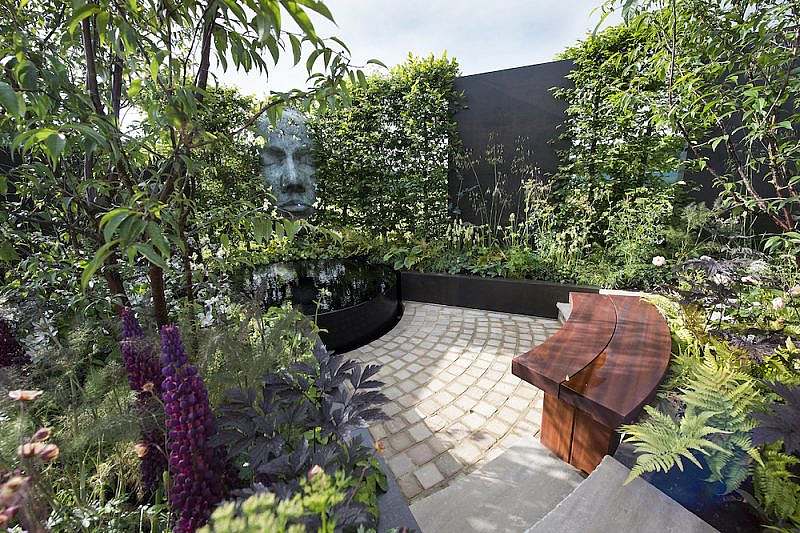
RHS show garden – sunken seating area
Tip for small garden design #2 – Divide the space
The best way to make a garden feel small is to have a single open space, use one material that stretches from each side of the garden to the other, and to have the whole boundary visible, which is why a typical modern garden, with one patio or lawn sandwiched between the house and a boundary fence, feels so small.
Carving a garden up into separate areas, similar to rooms in a house, is one of the most effective ways of making the garden feel larger. Physically dividing the garden using screens or trellis can create cosy hideaways, whilst arches or hedges can create doorways between spaces. You can even add a door in a boundary that doesn’t actually lead anywhere but creates the illusion of the garden appearing bigger than it is.
You may not be able to walk far, but your eye can be made to journey through a space by using hedges, raised beds, built in benches, small trees, focal points such as bowls, pots or specimen plants. Paradoxically a small space can be made to feel bigger by putting more into it. Whilst you don’t want to over clutter the garden or make it feel claustrophobic, you can divide up the garden so that your eye travels through the space and your brain is fooled into thinking the garden is larger than it is. Adding stopping off points such as a bench allow you to view the garden from different viewpoints.
A garden can seem larger and more intriguing if you can’t see it all at once. Don’t have the whole boundary visible, as seeing a fence running all the way round can make you feel more boxed in. You can use a short run of hedging, an upright-growing plant or a series of vertical posts masking what lies beyond, creating a sense of mystery and prompting you to ask ‘what is behind there? In our RHS Chatsworth show garden we included 3 trees which partially obscured the view of the garden from some angles and the garden revealed itself as you moved around.
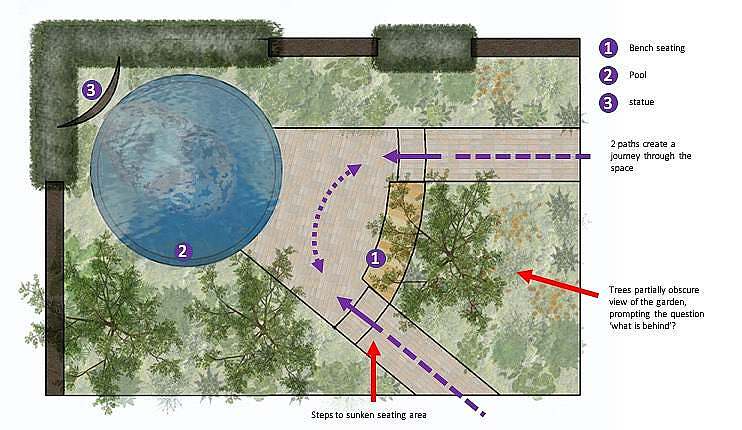
Plan of RHS Chatsworth garden
Tip for small garden design #3 – Use interesting angles and routes
Even in a small garden it is possible to create different ways of arriving at the point which makes the space seem much more interesting. Instead of having a straight path that just leads the eye down to the shed (which can be pretty boring!), layout paths with changes of direction that force you to see different things and take longer travelling through the space.
Instead of laying everything out at right angles to the house, use the diagonal as this is the longest sight line in a rectangular space. Instead of a rectangular lawn in the middle with narrow borders running round the edge, this also creates interesting triangular beds with more depth of planting.
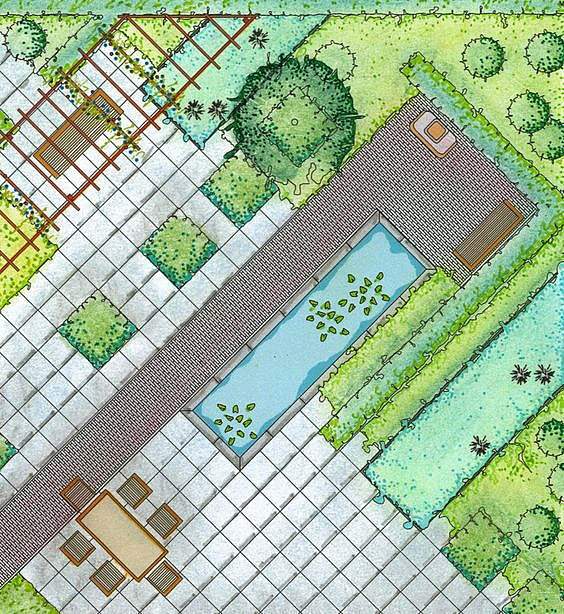
laying out a garden on the diagonal
Tip for small garden design #4 – Go vertical
Adding tall structures such as pergolas or obeliscs lead your eye upwards, taking your attention towards the sky and away from the limited ground space.
Trees of course add height and it can really be worth considering adding a tree, even in a small garden. There are plenty of trees that suit small gardens such as Amelanchier lamarckii which has a light canopy and a long season of interest.
When space is at a premium you can make the space feel bigger by utilising vertical surfaces. Green walls have become more popular and allow you to increase the amount of green in your garden by planting up a wall. Growing climbers up a fence or wall has a similar effect. Trachelospermum jasminoides is a good choice of climber as it is evergreen and provides a heavenly scent throughout the summer months.
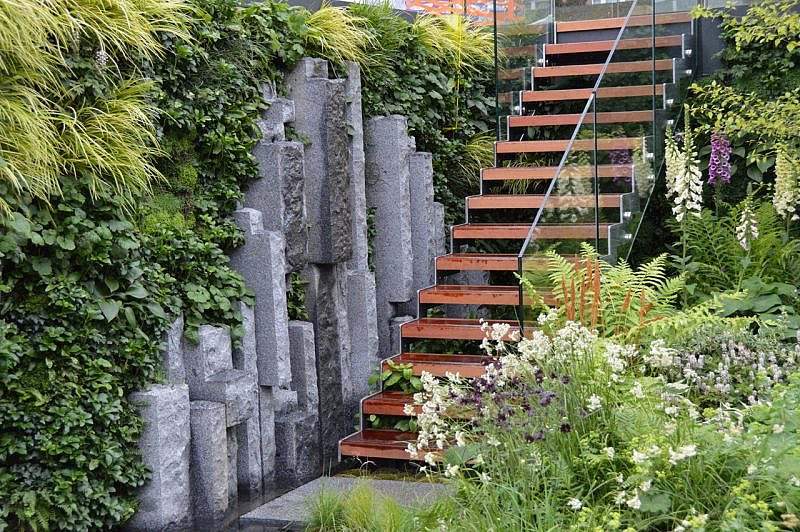
Creative use of height. Green wall and stone detailing
Tip for small garden design #5 – Link the garden with its surroundings
In some ways your garden doesn’t just stop at your legal boundaries, but includes everything you can see. If there are trees in the distance you can blur the boundaries by growing trees and shrubs that poke up above your fence and link with this ‘borrowed landscape’.
Small gardens offer more opportunities to make a direct link between the house and garden than larger properties. Bifold doors can be used to frame the view of the garden and focus the attention on lush greenery rather than neighbouring buildings. A focal point glimpsed within the garden from inside can be really effective.
Paving of a similar size and colour can be used inside and out to create a feeling of unity and connection. Unity can also be created by repeated elements – pots and containers, sculptural features.
Tip for small garden design #6 Right plant, right place
Small gardens often have microclimates caused by boundaries or surrounding buildings with some areas being in shade for much of the day. In shady areas use plants that will thrive there such as ferns and hostas. Create seating areas to capture the sun when you are most likely want it and include plants that need sun or partial shade to thrive.
At the same time try to limit your palette of plants. Rythym and repetition can make the garden feel more harmonious and relaxing. Repeating evergreen plants such as Yew balls create year round structure and link the garden together.
Cool colours like light-purples, whites and blues recede the field of vision, making a small space feel larger so it can be worth using these more towards the back of the garden. The colours of yellow, orange and bright pink leap forward and can be better placed nearer the house.
Large leaved plants such as Hostas are good choices for drawing the eye and creating impact. Another trick is to use these nearer the house with smaller leaved plants further away. The brain then overcompensates and calculates that the garden is longer than it actually is. This effect can be increased by using smaller sized paving slabs or setts further away from the house or exaggerating perspective by narrowing an area of paving as it gets further away.
If you have been spending more time at home recently and staring at your back garden feeling uninspired or not knowing where to start, we hope that some of the above tips will help you create a tranquil haven where you can relax and unwind. If you would like a fresh pair of eyes and some help creating your vision get in touch with us via our contact form.
If you don’t want to redesign your garden, but would would just like to enjoy your existing garden more, you can read the blog we wrote for the gardening for health charity Thrive.
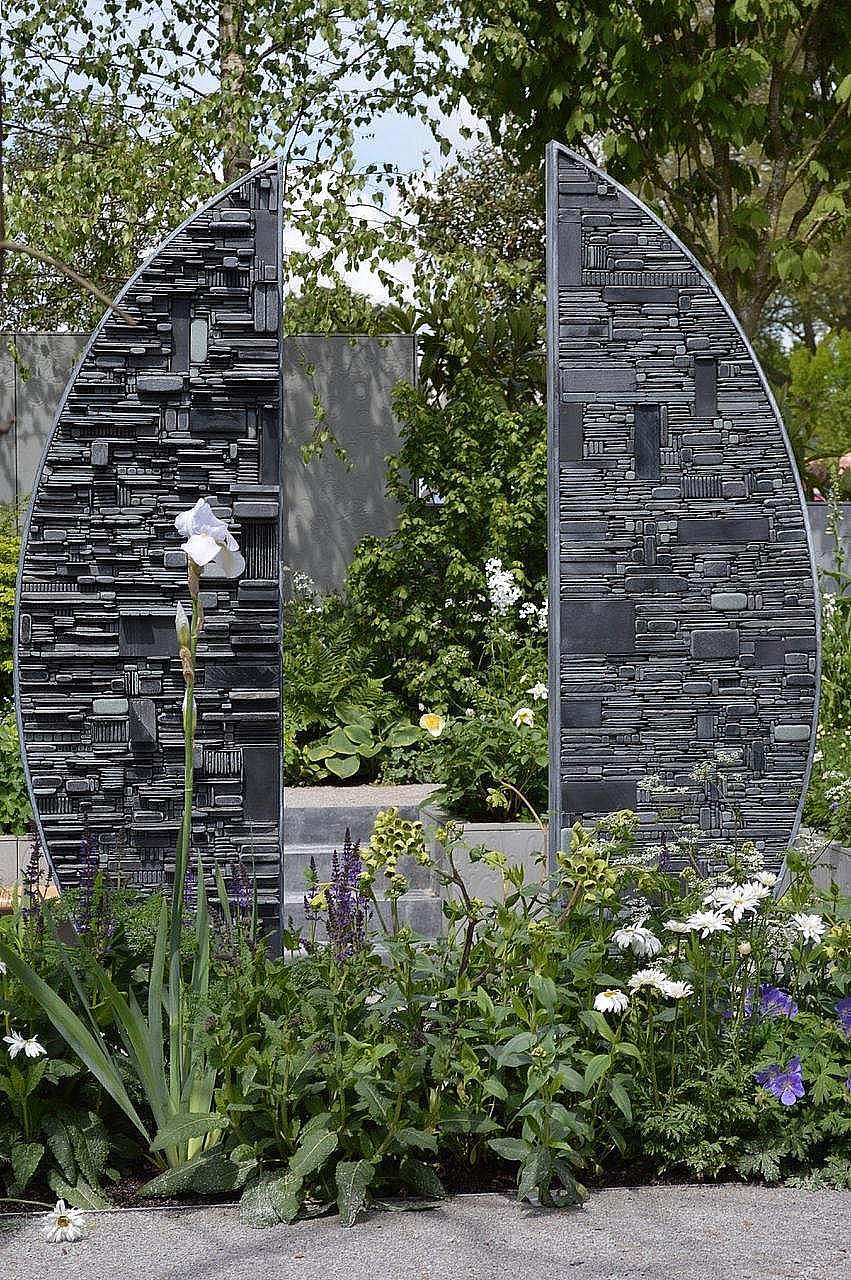
Just moved into a new build. You have filled me with inspiration and new ideas thank you
Hello Richard, I have a really small back yard and front garden. For years I grown plants in pots that are a nightmare to keep watered. I’d love to have raised beds for loads of lovely plants and maybe a few veg.